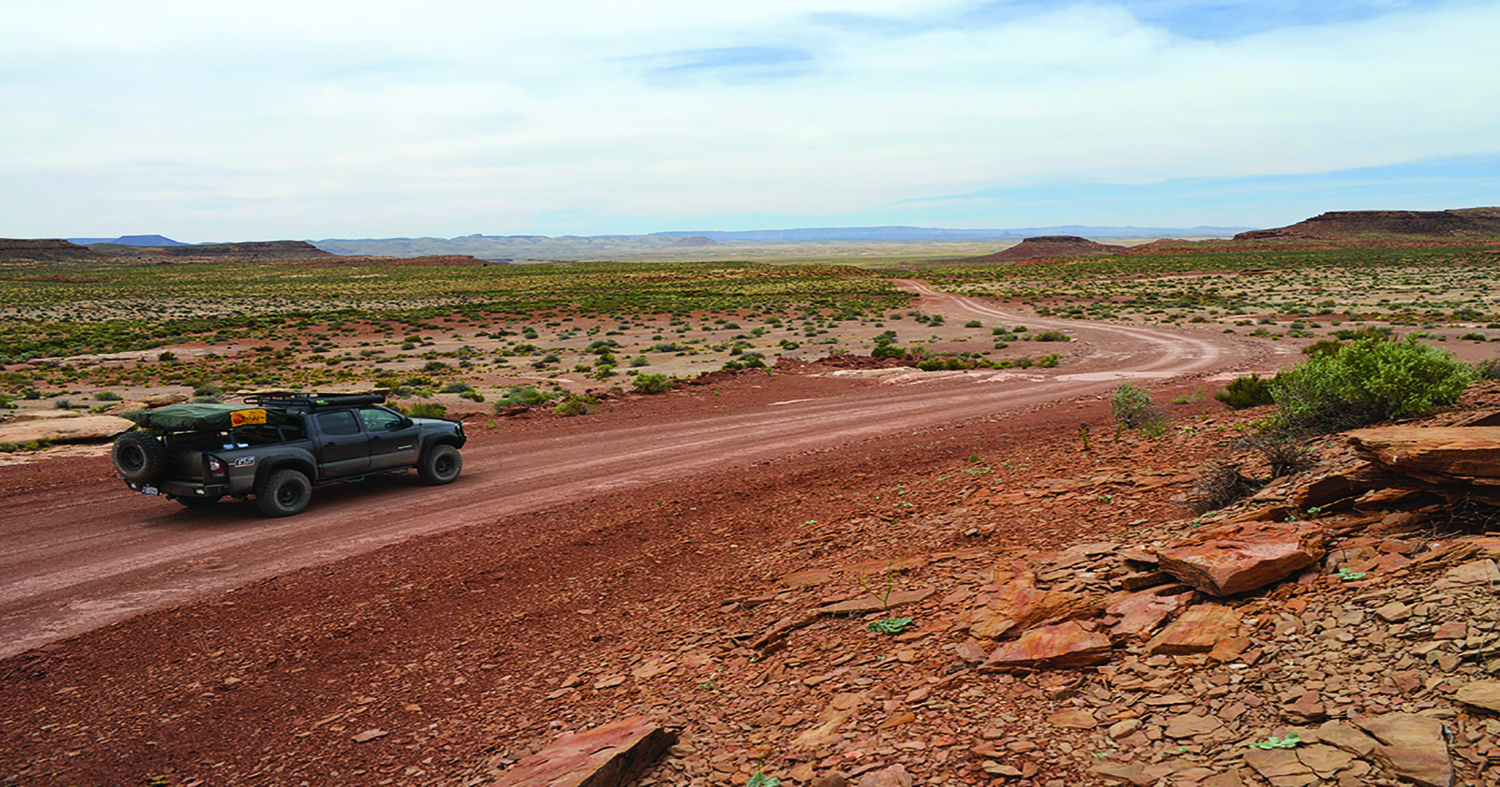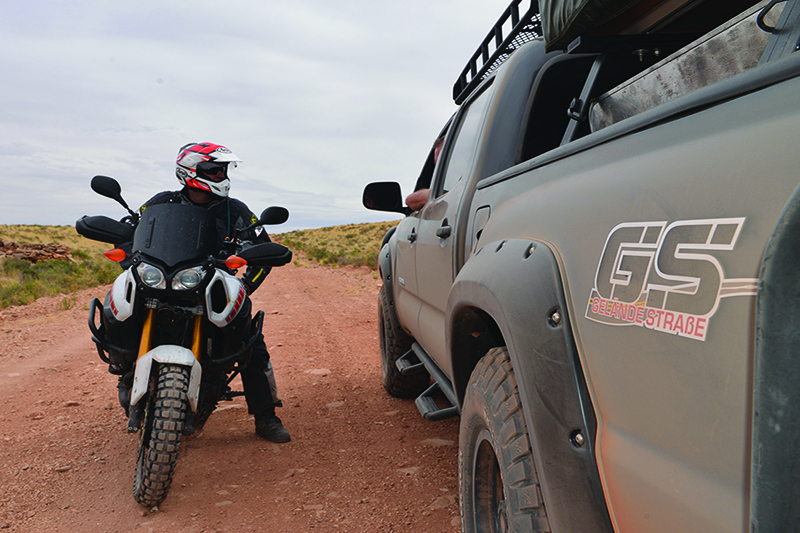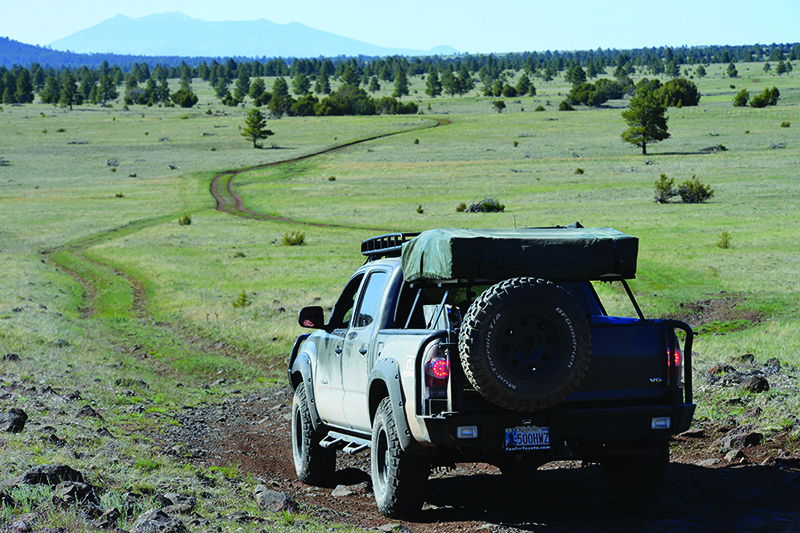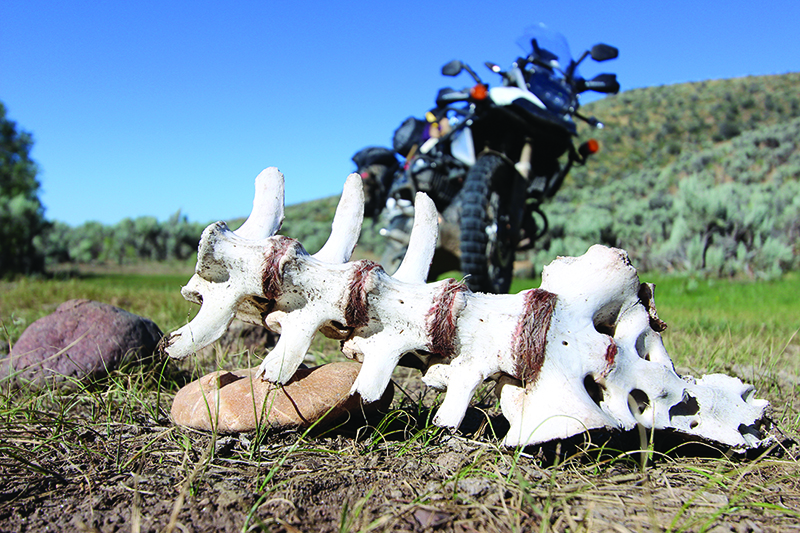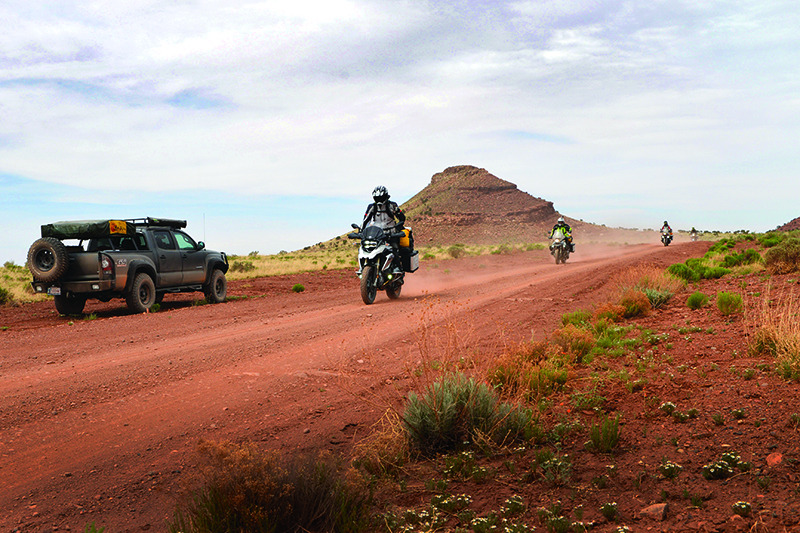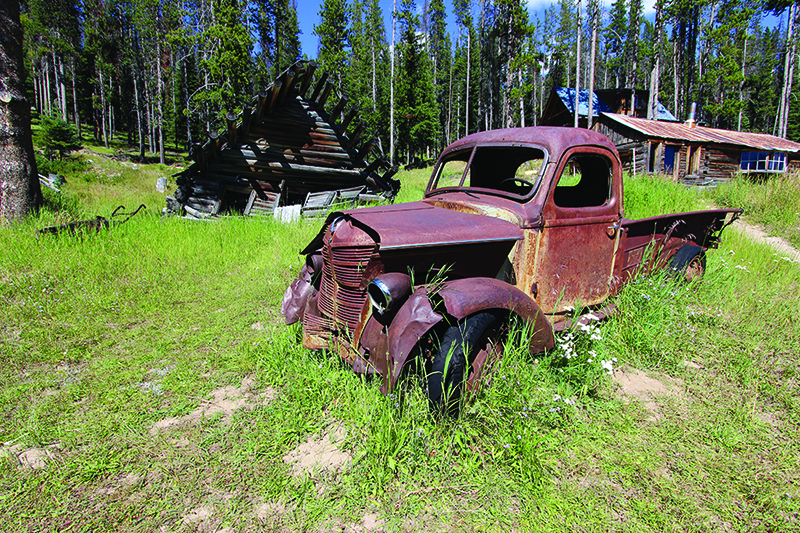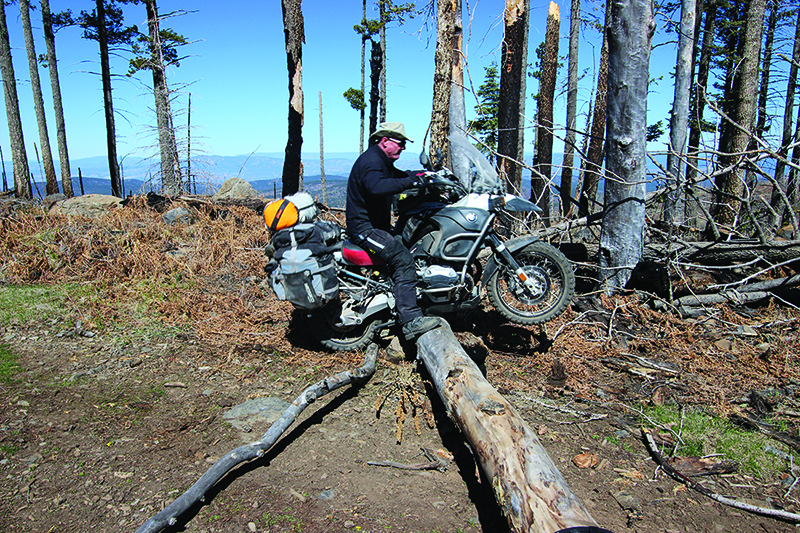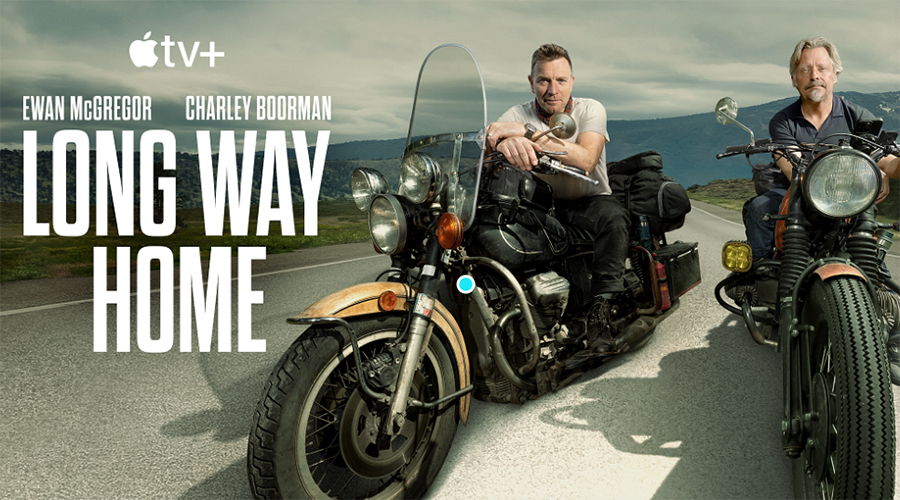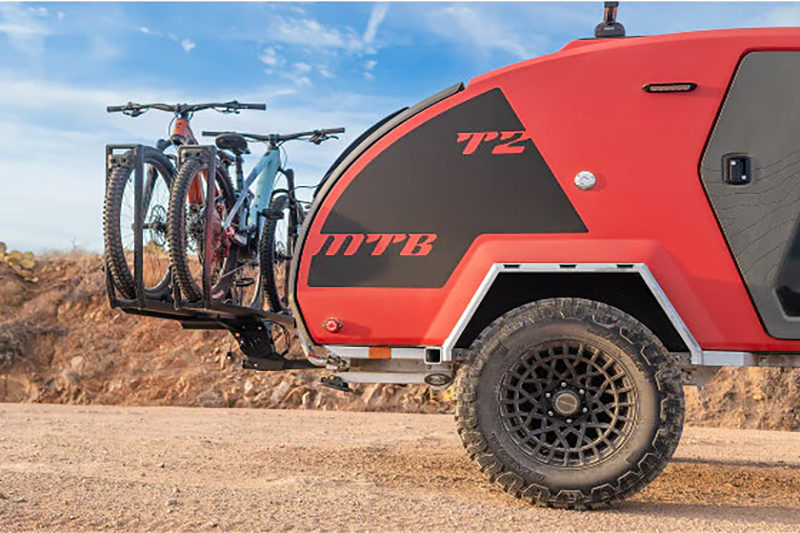Backcountry Discovery Routes are a series of off-highway routes for adventure motorcycle and overland travel
…Oh, a ten-dollar hoss and a forty-dollar saddle
And I’m goin’ to punchin’ Texas cattle
Come a ti yi yippee, come a ti yi yea
Come a ti yi yippee, come a ti yi yea…
Slogging through Chloride Canyon, crossing dozens of creeks and scrambling over slippery river-rock bottoms, the old cowboy song slips into my head. I think of the adventure riders of old as I wrangle the bars on my BMW R1200GS, taking in the timeless scenes along the New Mexico Backcountry Discovery Route, one of ten BDRs now in existence.
Originally a Plains Indian war and hunting route, the song’s subject, the Chisholm Trail, crossed Oklahoma from the southern border to the north and evolved into the main cattle route for driving herds to Kansas railheads, where they would bring top dollar. The once popular cattle route is all but gone now, with a few remaining traces and signs marking its passing. Most of the route is buried and barricaded by farmland, fences and fields of wind generators. Only the memories remain of cowboys driving their herds northbound through canyons, across creeks, rivers and prairie. But a new series of Chisholm-like trails has emerged out west, linking states by repurposing old roads and attracting modern cowboys on iron horses laden with state-of-the-art navigation technology and enough freeze-dried food to keep an astronaut in orbit for a week.
Two of those modern cowpokes, adventure motorcyclists Bryce Stevens, founder of Trails.com, and Andrew Cull, CEO of Remote Medical Inc., were inspired to bring new life to the concept as they sat over a beer discussing how they might create an off-pavement route from Oregon through their home state of Washington to Canada. They would call it a Backcountry Discovery Route (BDR), a play on the original Oregon BDR, an older route of the same name, now managed by the Oregon Off-Highway Vehicle Association. Washington was only the first of the new generation of BDRs, which now includes Utah, Arizona, Colorado, Idaho, New Mexico and, most recently, Nevada.
What is a Backcountry Discovery Route?
Backcountry Discovery Routes are an organized collection of existing, typically north/south roads and trails through some of the best remote parts of the aforementioned seven western states. Instead of a route for cattle drives, they carry people back in time aboard their purpose-built machines. Each BDR is selected for its scenic geographical highlights, points of historical significance, remaining relics from the westward movement, and the occasional technical challenge. Terrain varies widely as do road conditions. From narrow two-track ORV trails to deep sand washes, desert floor to mountain passes, anything goes on a BDR. The intention, however, is to offer reasonably accessible routing, selected to provide a challenge, but hopefully not prove impassable to an accomplished rider during the prime seasons. Weather, rock slides and trees felled by storms can force a change of plans, just as a rain-swollen creek could stop a herd, wreaking havoc on a cattle drive. It’s all part of the adventure.
GPS Tracks are available at no charge on the BDR website, as are video clips describing what to expect. Butler Maps and feature-length DVDs of the entire route can be purchased to whet the appetite of anyone planning their own drive. The DVDs are also great for club gatherings or casual entertainment.
BDRs have been a blessing to small western towns and businesses, many which have barely survived on local traffic, ranchers and the occasional hardy overlander. With the increasing popularity of these published routes, more and more travelers are venturing into the deserts, canyons and mountains on two wheels and four, Butler map in hand and free GPS tracks locked and loaded.
Bryce and Andrew were joined by Tom Myers and Paul Guillien of Touratech U.S.A., distributors of fine adventure motorcycle accessories, and filmmaker Sterling Noren to tackle the monumental task of blazing and mapping trails, filming, and publishing a website for what has become perhaps the most popular series of off-pavement motorcycle (and rapidly becoming overlanding) routes on the planet. Rob Watt is the trail master, tirelessly tracing and retracing prospective routes and exploring afield for more BDRs across the continent. The project is now governed by a Board of Directors, and users can help expand the effort by becoming annual BDR members or donating to the BDR fund.
…As I climb the switchbacks leading out of Chloride Canyon, the song fades from my mind and I reminisce about the other BDRs I’ve explored. I don’t want this one to end, but I am eager to get on to Nevada, number seven, and see what it has to offer.
Preparing for a Backcountry Discovery Route
- Maps, GPS routes, and videos are available to help you pre-run the course before leaving the driveway.
- Services out west are sometimes few and far between. BDR maps identify where to get food, fuel etc.
- Camping and other overnight accommodations are noted.
- Travel time can be discerned without a lot of experimentation.
- Updates are available on each BDR website, explaining areas of trail damage, closures, etc.
- BDRs are not over-developed. There is still plenty of adventure on tap once you begin.
Why prepare?
A fellow once asked me the day before a ride across one of the western states if Metzler Tourance (80/20) tires would be okay for his big adventure bike. It was a season of bad weather and we would be off road most of the weeklong trip. Sand, mud and snow were prevalent. At one point we found ourselves pushing, digging mud from the front fenders, and racing plummeting temperatures after dark to get over a pass and down to lower, warmer elevations where we could camp. It is imperative that you have some idea what you might encounter before setting off on a BDR. The route plan has already been prepared for you and should be studied, with consideration for current weather conditions, enough to have a feel for what each day might entail, where you can camp, obtain fuel and find an exit if the need arises.
Prepare yourself, your bike and your gear.
I seldom use checklists, but my wife always does. Last year I had a flat in Arkansas. When I reached for my spare tube, it was gone. I’d left it sitting on my workbench. Seven failed attempts to patch a borrowed oversized tube later, my organized and heroic wife drove two and a half hours to bring me a tube. You might consider using a checklist. Make it pertinent to your rig and the degree of luxury you prefer, and consider the emergency equipment needed for self-recovery in case you are stranded.
Prepare yourself with fitness.
BDRs are miles and miles of roads, some easy, some moderately challenging and some, at times, impassable. Exertion can be required for a moment, an hour or more. On the New Mexico BDR last spring, we came across a couple miles of deadfalls lying across the entire mountain pass. Wind had blown them down that winter and the pass had not yet been opened. We were determined to make it through so we began moving logs and stacking debris to get the bikes over those that were too large to move. Most were rideable with a little applied skill and aggression, but by the end of the section, we were beat. A trail paved with loose baby heads was our path back down and had it not been for a reasonable level of fitness, we’d have been forced to bivouac there at altitude until morning. It could have been a chilly night.
Back-to-back days in the saddle can also take a toll. Once fatigue sets in, riding or driving can become dangerous. A friend told me of her experience last year, breaking a collarbone. Her group was trying to make it to a planned campsite before dark. The leader pushed the pace, forcing her to ride over her head. She became exhausted and asked that they stop where they were, but the group wanted to move on. They rested a few minutes before setting off again with even more urgency. She felt the pressure to keep up and did her best. As they came into a technical section of rocks, she had nothing left to help her manage her F800GS and she bounced off a rock into a larger boulder, which subsequently launched her into the rocky trail. Her shoulder and collarbone were smashed. Needless to say, it was a rough evening as they engineered her out of the woods and to a hospital. She carries metal in her shoulder to this day as a reminder that she should have prepared herself for the exertion.
The best form of motorcycle training is, of course, riding, but it should be fairly aggressive riding, taxing the system for an extended time. The gym is reliable and always available. Training core, cardio and limbs prevents soreness and helps your body endure the rigors of long days and difficult terrain. Find a training routine that is fun, diverse and relevant. Stick to it. Often having an upcoming ride as a goal is a good way to stay motivated.
Prepare your skill
BDRs are arranged to accommodate riders of moderate skill. Route options are available for higher-level challenges, but riding, wrenching and recovery skills should be sharpened before setting off.
Consider taking a rider training course ahead of time, leaving time to practice and perfect what you learned in class.
Can you change a tire? Don’t rely on luck to prevent a flat or a partner to fix it for you. Sometimes fellow travelers are forced to turn back due to mechanical issues, concerns at home, health or injury. Even if traveling as a group, be prepared to be self-supporting if needed or risk cutting your adventure short. Basic skills like chain maintenance, field tire repair such as repairing a torn sidewall, patching an engine case or truing a wheel with a broken spoke are all skills you might need. Can you siphon gas or restore a drowned engine? Consider learning.
Prepare your machine
Just because it worked yesterday doesn’t mean your motorcycle will make it through today. Spend some time going over all hardware to ensure it’s tight. Pay special attention to subframe mounts, accessory hardware and plastics like hand guards and windshields. It can be tough to find the proper metric bolt in a town with 30 permanent residents and a few dusty bins of SAE bolts.
Perform services well ahead of your departure time. Breakdowns are often the result of servicing…loose bolts, misadjustments, fluids left out, brakes or chain too tight. Nobody is perfect. Test your maintenance before you have to rely on it.
Inspect and replace worn components before setting off. Nobody wants to have to hang with a guy with a broken throttle cable when it could have been prevented with a little foresight. If your motorcycle is getting up in the miles, take things apart to check them. Steering head bearings, swingarm pivots and wheel bearings are common points of failure on higher mileage machines. If your rear sprocket is developing hooks, chances are your countershaft sprocket is about done for. It turns three to four times for every revolution of the rear so be aware and lay eyes on it.
Know how to defeat known safety switch issues as a field repair. Clutch and sidestand switches often cause failures, either when impacted or just when malfunctioning. If you break a clutch lever and don’t have a spare, you may need to start the bike in gear to proceed. That won’t work with an operable clutch safety switch so learn to wire around it if necessary.
Prepare your gear
Pack it light, pack it tight. Give the weather a look and minimize what you must take. Electric gear is the lightest, warmest way to travel on or off pavement. Even a smaller dual-sport machine can handle an electric vest of 60 watts or so, more if light bulbs are replaced with low consumption LEDs.
Use compression sacks for your tent and sleeping bag. A small bottle of laundry soap takes up a lot less room than multiples of socks and underwear. Take only one pair of street pants…synthetic material, not jeans. Undershirts like Klim base layers beneath the jersey can be swapped out frequently, preventing the need to carry several jerseys or to wash them often. They are also double as street wear. Two or three such undershirts with one jersey easily last a week or more if you wash out your base layers nightly or at a gas or lunch stop. Dry them on the bike while riding or when stopped.
Look for things that rub, burn or create discomfort while riding. Exhaust gasses can melt soft luggage or straps. Make sure you have a heat shield or deflector if you suspect any chance of an issue.
Soft luggage is less convenient but much safer than hard panniers. Large tail boxes are bad news. Unless you must use a hard case to protect or secure expensive camera gear, use a soft tail bag. Tools and other hard items bounce around in boxes, wearing holes in whatever touches them. A tailbag compresses, binding items and minimizing movement.
Do you have a large tailbag or tank bag? A camel is fine for crossing the desert at a Bedouin pace, but turning your motorcycle into one is a recipe for disaster when the going gets rough. You need room to move, so don’t overload your bike.
Don’t over-prepare.
Much of the fun of any adventure ride is tackling the challenges along the way. If your preparation is balanced and based upon experience, yours and that of others you trust, chances are you will be equipped to deal with most situations that may arise. Carrying spare parts you should have replaced preemptively begs a trailside repair and costs weight and space. Carrying a spare chain and sprockets while neglecting to replace a sticky throttle cable can leave you overloaded and, eventually, walking. Use foresight to choose what to take and what to replace beforehand.
Camp furniture, large tents and thick sleeping pads are a few examples of excess. Consider how often you’ll be hanging out in camp versus riding until sunset. Take a creature comfort or two if you must, but heir on the lean side. Don’t try to take it all.
Planning is half the fun and the BDR website provide many of the resources to make the process a joy. Start early and prepare yourself, your bike and your gear, then sit back and listen to the coyotes as you fall asleep somewhere far from home, knowing you are ready for whatever challenge the trail might bring.
Resource:
http://www.ridebdr.com/
- Editor’s Note: For tips on preparing for the physical aspect of traveling along a BDR, check out Issue 19’s article entitled Fit for Overlanding and also viewable HERE.
OutdoorX4 Magazine – Promoting responsible vehicle-based adventure travel and outdoors adventure


